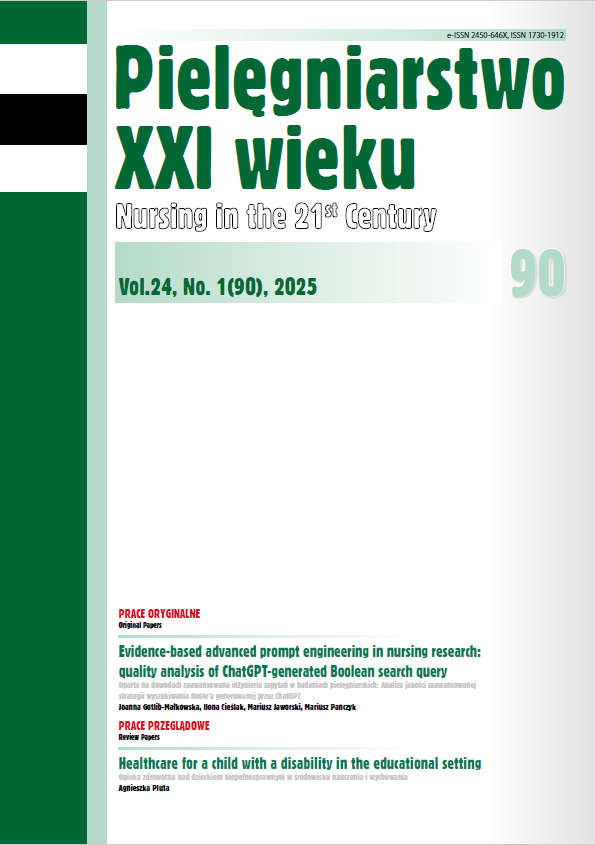Badanie jakości środowiska edukacyjnego w Słowacji i Czechach z wykorzystaniem inwentarza DREEM
DOI:
https://doi.org/10.12923/pielxxiw-2025-0006Słowa kluczowe:
edukacja, studenci, pielęgniarstwo, środowisko uczenia sięAbstrakt
BADANIE JAKOŚCI ŚRODOWISKA EDUKACYJNEGO W SŁOWACJI I CZECHACH Z WYKORZYSTANIEM INWENTARZA DREEM
Cel pracy. Badanie miało na celu ocenę i porównanie postrzegania przez studentów pielęgniarstwa ich środowiska edukacyjnego na uniwersytetach na Słowacji i w Czechach, zbadanie różnic w zależności od płci i lokalizacji oraz zidentyfikowanie obszarów wymagających poprawy.
Materiał i metody. Badanie ilościowe z udziałem 742 studentów pielęgniarstwa przeprowadzono przy użyciu inwentarza DREEM. Dane zostały zebrane w 2021 r. i przeanalizowane za pomocą SPSS, przy użyciu statystyk opisowych i testu U Manna-Whitneya do oceny różnic między grupami.
Wyniki. Studenci pielęgniarstwa ogólnie pozytywnie postrzegali swoje środowisko edukacyjne, bez znaczących różnic w zależności od płci lub lokalizacji. Podczas gdy wyniki DREEM wskazywały na wspierające praktyki, niższe wyniki w atmosferze edukacyjnej podkreślały potencjalne obszary wymagające poprawy.
Wnioski. Regularna ocena za pomocą narzędzi takich jak DREEM jest niezbędna do utrzymania wysokiej jakości edukacji pielęgniarskiej. Chociaż wyniki były pozytywne, potrzeba poprawy wsparcia emocjonalnego i społecznego dla studentów pozostaje wyraźna.
Bibliografia
1. Bakhshialiabad H, Bakhshi G, Hashemi Z, et al. Improving students’ learning environment by DREEM: an educational experiment in an Iranian medical sciences university (2011-2016). BMC Medical Education. 2019; 19(1): 397.
2. Cornelius-White J. Learner-Centered Teacher-Student relationships are effective: a meta-analysis. Review of Educational Research. 2007; 77(1): 113-143.
3. Branch WT, Paranjape A. Feedback and reflection: teaching methods for clinical settings. Acad. Med. 2002; 77(12 Pt 1): 1185-1188.
4. Sayfulloevna SS. Safe learning environment and personal development of students. International Journal of Formal Education. 2023; 2(3): 7-12.
5. Valerio K. Intrinsic motivation in the classroom. Journal of Student Engagement: Education Matters. 2012; 2(1): 30-35.
6. Pimparyon SMC S, Pemba S, Roff P. Educational environment, student approaches to learning and academic achievement in a Thai nursing school. Medical Teacher. 2000; 22(4): 359-364.
7. Dyrbye LN, Thomas MR, Shanafelt TD. Medical student distress: causes, consequences, and proposed solutions. Mayo Clin. Proc. 2005; 80(12): 1613-1622.
8. Shrestha E, Mehta RS, Mandal G, et al. Perception of the learning environment among the students in a nursing college in Eastern Nepal. BMC Medical Education. 2019; 19(1): 382.
9. van den Berg B a. M, Bakker AB, Ten Cate TJ. Key factors in work engagement and job motivation of teaching faculty at a university medical centre. Perspect Med Educ. 2013; 2(5-6): 264-275.
10. McAleer SR Sean. What is educational climate? Medical Teacher. 2001; 23(4): 333-334.
11. Vaughan B, Carter A, Macfarlane C, et al. The DREEM, part 1: measurement of the educational environment in an osteopathy teaching program. BMC Medical Education. 2014; 14(1): 99.
12. Rothman AI. Learning environment of a medical school: expectations versus perceptions of a first-year class. Medical Education. 1970; 4(4): 289-292.
13. Marshall RE. Measuring the medical school learning environment. Academic Medicine. 1978; 53(2): 98.
14. Tackett S, Bakar HA, Shilkofski NA, et al. Profiling medical school learning environments in Malaysia: a validation study of the Johns Hopkins Learning Environment Scale. J. Educ. Eval. Health Prof. 2015; 12: 39.
15. Roff S, McAleer S, Harden RM, et al. Development and validation of the Dundee Ready Education Environment Measure (DREEM). Medical Teacher. 1997; 19(4): 295-299.
16. Pai PG. Medical Students’ Perception of Their Educational Environment. JCDR [Internet]. 2014 [citován 31. srpen 2024]; Available from: http://www.jcdr.net/article_fulltext.asp?issn=0973-709x&year=2014&volume=8&issue=1&page=103&issn=0973-709x&id=3944
17. Roff S. The Dundee Ready Educational Environment Measure (DREEM) - a generic instrument for measuring students’ perceptions of undergraduate health professions curricula. Medical Teacher. 2005; 27(4): 322-325.
18. Arzuman H, Al-Mahmood AK, Islam S, et al. Students perception of learning environment: A Base Line Study for identifying areas of concern at a Private Medical College, Bangladesh. Bangladesh Journal of Medical Science. 2016; 15(2): 234-242.
19. Roff S, McAleer S, Ifere OS, et al. A global diagnostic tool for measuring educational environment: comparing Nigeria and Nepal. Medical Teacher. 2001; 23(4): 378-382.
20. Damiano RF, Furtado AO, da Silva BN, et al. Measuring Students’ Perceptions of the Medical School Learning Environment: translation, transcultural adaptation, and validation of 2 instruments to the Brazilian Portuguese Language. J. Med. Educ. Curric. Dev. 2020; 7: 2382120520902186.
21. Hammond SM, O’Rourke M, Kelly M, et al. A psychometric appraisal of the DREEM. BMC Medical Education. 2012; 12(1): 2.
22. Salminen L, Stolt M, Saarikoski M, et al. Future challenges for nursing education--a European perspective. Nurse. Educ. Today. 2010; 30(3): 233-238.
23. Lahtinen P, Leino-Kilpi H, Salminen L. Nursing education in the European higher education area - variations in implementation. Nurse. Educ. Today. 2014; 34(6): 1040-1047.
24. Cranage K, Foster K. Mental health nurses’ experience of challenging workplace situations: A qualitative descriptive study. Int. J. Ment. Health Nurs. 2022; 31(3): 665-676.
25. Al-Kabbaa AF, Ahmad HH, Saeed AA, et al. Perception of the learning environment by students in a new medical school in Saudi Arabia: Areas of concern. Journal of Taibah University Medical Sciences. 2012; 7(2): 69-75.
Pobrania
Opublikowane
Numer
Dział
Licencja
Prawa autorskie (c) 2025 Autorzy

Utwór dostępny jest na licencji Creative Commons Uznanie autorstwa 4.0 Międzynarodowe.




